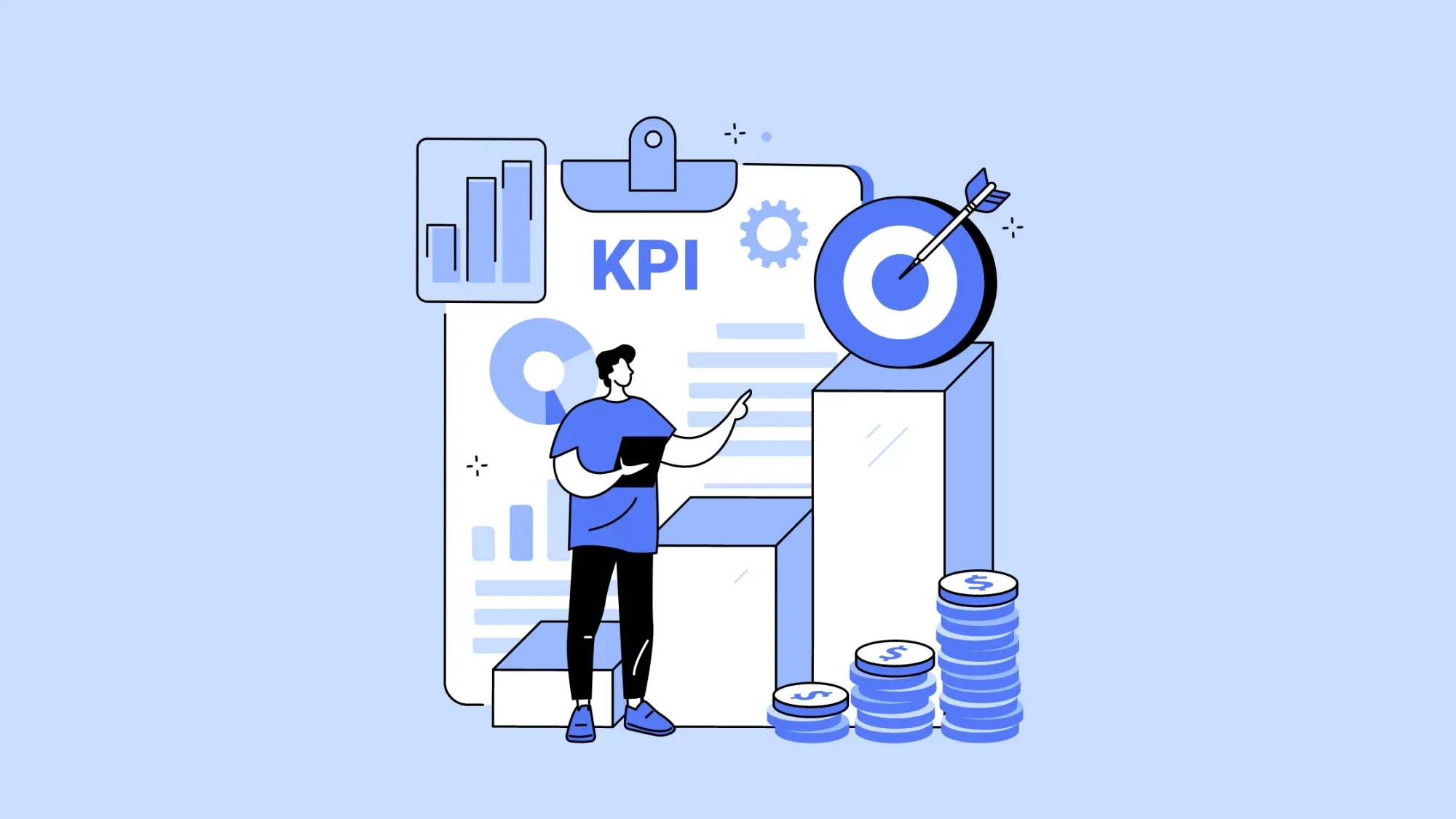Top 7 KPIs and Metrics to Track for Small Business Owners
Learn how KPIs tracking can improve your business: revenue growth rate, expenses, cash flow, churn rate, conversion rate & funnel analysis, LTV.

Small business owners are always looking for ways to improve their businesses. One of the best ways to do this is by tracking key performance indicators, or KPIs. By monitoring these metrics, you can see exactly how your business is performing and make changes as needed. In this blog post, we will discuss the top 7 KPIs and metrics that small business owners should track. Knowing where your business stands in relation to these numbers is critical to making informed decisions about the future of your company.
What is KPI (Key Performance Indicators)?

So, what is a KPI? A key performance indicator is a metric that is used to measure and track progress towards a specific goal. KPIs can be financial or non-financial, and they vary depending on the industry and type of small business. However, all businesses should have KPIs in place to help them make informed decisions about their operations.
Why Tracking KPIs is Important?
You might be thinking, "I'm a small business owner, not a data analyst. I don't have time to track KPIs and metrics." But the truth is, if you want your business to succeed, you need to track KPIs. By tracking KPIs, you can make informed decisions about where to allocate your resources. You can also measure your progress and identify areas of improvement.

There are a plethora of KPIs and metrics to monitor, but you should start with your company's objectives and the goals you are trying to achieve.
Once you know what you want to track, you can select the KPIs that are most relevant to your business. For example, if you're trying to increase sales, you might track KPIs such as conversion rate or customer lifetime value.
Top 7 KPIs every small business owner should track
Although it is ultimately up to you to pick which KPIs are appropriate for your company, I've compiled a list of ten of the most frequent KPIs that business owners should consider tracking.
1. Revenue Growth Rate
This is arguably the most important KPI for small businesses. After all, revenue is what keeps your business afloat. You can track revenue on a monthly or quarterly basis to get an idea of how your business is performing.

Be sure to track gross revenue as well as net revenue. Net revenue is your total revenue minus returns, refunds, and discounts.
By tracking revenue, you can see whether your business is growing or stagnating. If you notice that revenue is decreasing, you can take steps to correct the problem. For example, you might need to invest in marketing or product development.
Revenue is a good metric to track if you want to get an overview of your business's growth and performance. However, it's important to track other metrics as well, because revenue doesn't always tell the whole story.
For example, you might have a thriving business with high revenue but low-profit margins. In this case, you would want to focus on reducing expenses or increasing prices.
2. Expenses
Monitoring your business's expenses is crucial to maintaining a healthy bottom line. You can track expenses on a monthly or quarterly basis, and I recommend categorizing them so you can see where your money is going.

Categorizing expenses can also help you identify areas of unnecessary spending. For example, if you notice that you're spending a lot of money on office supplies, you might want to shop around for a cheaper supplier.
Tracking expenses is also helpful if you're trying to reduce your business's carbon footprint. By monitoring your energy and water usage, you can identify areas where you can be more sustainable.
Reducing expenses and, as a result, operating costs is a great way to increase profits. However, you don't want to cut too many corners, as this can negatively affect the quality of your products or services.
3. Cash Flow

One of the most important small business metrics is cash flow. This measures how much money is coming in and going out of your business. To track this, you need to look at your accounts receivable and accounts payable. Accounts receivable is the money that customers owe you, while accounts payable is the money that you owe to suppliers. You can improve your cash flow by increasing the amount of money coming in and decreasing the amount of money going out.
Another way to improve your cash flow and monthly recurring revenue is to offer discounts to customers who pay their invoices early. This will encourage them to pay sooner, which will help you have more money on hand. You can also set up a line of credit with your bank. This will give you a source of emergency funding if you need it.
4. Churn Rate

Churn rate is one of the most important KPIs for small business owners because it measures how many customers or clients are leaving your company. A high churn rate could be a sign that your products or services are not meeting customer needs, or that your prices are too high. You can calculate your churn rate by dividing the number of customers or clients who cancel their service in a given period by the total number of customers or clients you had at the beginning of that period. For example, if you start the month with 100 customers and 20 of them cancel their service, your churn rate would be 20%.
If you have a high churn rate, it’s important to take steps to improve it. You can do this by surveying your customers to find out why they’re leaving, and then making changes to your products or services accordingly. You may also want to consider offering discounts or other incentives to keep customers from canceling their service.
Resources:


5. Conversion Rate & Funnel Analysis
One of the most crucial KPIs for small company owners is conversion rate. It's a metric that tells you how many visitors to your website take the desired action, such as making a purchase or subscribing to a service. By tracking your conversion rate, you can identify areas of your website or sales process that need improvement.

Funnel analysis is another important metric for small business owners. It allows you to track the progress of your leads through your sales process. By understanding the sales funnel and where most of your leads drop off, you can make changes to improve your conversion rate.
Both conversion rate and funnel analysis are essential metrics for small business owners because they provide insights into how well your business is performing and where there are opportunities for improvement.
If you're not tracking these KPIs, you're missing out on valuable data that can help you grow your business. Start tracking them today to get a better understanding of your business's marketing performance.
6. Marketing ROI
This is a metric that allows you to track the return on investment for your marketing campaigns. This is important because it allows you to see which marketing campaigns are working and which ones are not. If you are not tracking this metric, you could be wasting a lot of money on ineffective marketing campaigns.

To calculate your marketing ROI, simply divide your total marketing costs by the number of new customers you acquired from your marketing campaigns/channels.
For example, if you spent $100 on a Facebook ad campaign and it generated 20 new leads, your marketing ROI would be 20%.
Google Analytics can help to calculate how well your marketing campaigns are doing. You can see how much money you have spent on google ads, and how many new customers you have gotten from those campaigns.
If you have several marketing platforms, Google Analytics goals and conversions can be used to measure the efficacy of your campaign.
7. Average Revenue per Customer & Lifetime Value
Customer Lifetime Value (LTV) is the net present value of the cash flows from the entire future relationship with a customer. In other words, it’s an estimate of how much profit you can expect to make from each customer over the course of your relationship.

The lifetime value of a customer is a key metric for any small business. By understanding your LTV, you can make smarter decisions about where to focus your marketing efforts and how much to spend on acquiring new customers.
There are a few different ways to calculate lifetime value, but the most important thing is to use a consistent method so that you can track changes over time.
There are a number of different factors that go into calculating LTV, but the two most important are average revenue per customer and customer retention rate.
Average Revenue per Customer is simply the average amount of money that each customer spends with your business over time. To calculate this, you can take your total revenue over a certain period of time and divide it by the number of customers you had during that period.
Customer Retention Rate is the percentage of customers who continue to do business with you over time. To calculate this, you can take the number of customers you had at the beginning of a certain period and divide it by the number of customers you had at the end of that period.
You can use these two metrics to calculate a rough estimate of lifetime value by taking the average revenue per customer and multiplying it by the customer retention rate. For example, if your average revenue per customer is $100 and your customer retention rate is 50%, then your estimated LTV would be $50.
Of course, this is just a rough estimate, and there are a number of other factors that can affect lifetime value, such as customer acquisition costs, average order size, and so on. But if you track these two key metrics over time, you’ll be well on your way to understanding the lifetime value of your customers.
Summary
The most successful companies employ KPIs in some form to measure company accomplishments. As a small business owner, you should strive to integrate KPIs into your strategic plan. Doing so will give you a clear understanding of what areas need improvement and where your company is excelling. While there are many different KPIs you can track, the ones listed above are some of the most important for small businesses. By tracking these metrics, you’ll be able to make better strategic decisions that will help your business grow.

